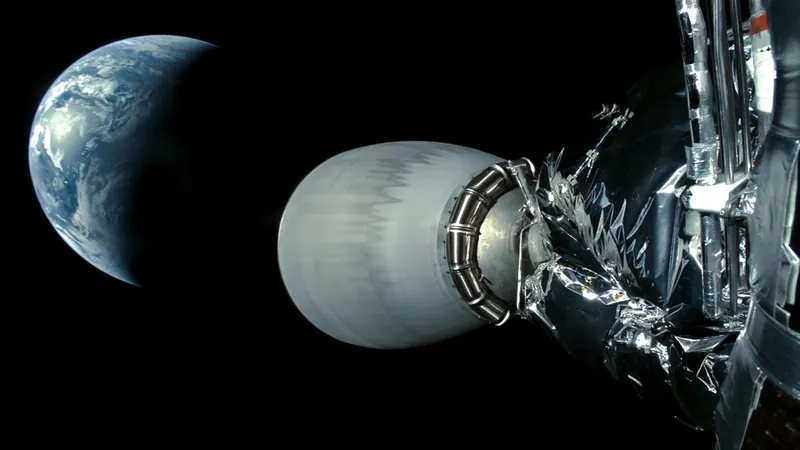
Stunning SpaceX Launch Captures Earth's Beauty as They Propel Hera Toward Asteroid System
2024-10-08
Author: Jessica Wong
Stunning SpaceX Launch Captures Earth's Beauty as They Propel Hera Toward Asteroid System
On October 7, the SpaceX Falcon 9 rocket delivered breathtaking views of our planet during a significant mission. As the spacecraft ascended into the cosmos, it captured a remarkable in-space selfie, showcasing the spectacular sight of Earth suspended in the vastness of space, framed by the nozzle of the Falcon 9's upper-stage Merlin engine.
What sets this image apart is that Earth appears smaller than usual in launch photos. This phenomenon occurred because the upper stage was moving toward an interplanetary transfer orbit, placing it at a considerable distance from our planet's surface. Approximately 76 minutes after liftoff, the Falcon 9 successfully deployed the Hera spacecraft, marking a pivotal moment in space exploration.
However, the journey to that orbit took its toll on the Falcon 9's first stage. The booster reached the end of its fuel reserves and was unable to return to Earth for a controlled landing, rendering this mission its 23rd and final flight—a notable achievement that ties a record for SpaceX's reusable rockets. "Farewell, 1061, and we thank you," declared John Insprucker, a SpaceX principal integration engineer, during the launch commentary, paying tribute to the booster that has served so well.
The Hera mission, orchestrated by the European Space Agency, sets its course for an intriguing binary asteroid system comprised of the larger asteroid, Didymos, and its smaller companion, Dimorphos. If all goes according to plan, Hera will arrive at its destination by late 2026. This mission serves as a continuation of NASA's groundbreaking efforts following the Double Asteroid Redirection Test (DART) in September 2022. DART intentionally collided with Dimorphos, showcasing a potential defense strategy against future asteroid threats to Earth.
The Hera spacecraft is poised to play a critical role in understanding the aftermath of DART's impact. It will conduct detailed assessments of the crater created by the spacecraft’s collision and confirm various alterations discovered through remote observation and theoretical modeling. Notably, Hera's data will provide valuable insights into how DART's impact affected the orbital dynamics of Didymos, paving the way for enhanced planetary defense strategies.
This extraordinary collaboration between space agencies underscores humanity's commitment to safeguarding our planet while exploring the cosmic wonders that lie beyond. As we embark on this journey with Hera, the quest to understand, mitigate, and protect against potential asteroid threats becomes ever more paramount.



 Brasil (PT)
Brasil (PT)
 Canada (EN)
Canada (EN)
 Chile (ES)
Chile (ES)
 España (ES)
España (ES)
 France (FR)
France (FR)
 Hong Kong (EN)
Hong Kong (EN)
 Italia (IT)
Italia (IT)
 日本 (JA)
日本 (JA)
 Magyarország (HU)
Magyarország (HU)
 Norge (NO)
Norge (NO)
 Polska (PL)
Polska (PL)
 Schweiz (DE)
Schweiz (DE)
 Singapore (EN)
Singapore (EN)
 Sverige (SV)
Sverige (SV)
 Suomi (FI)
Suomi (FI)
 Türkiye (TR)
Türkiye (TR)